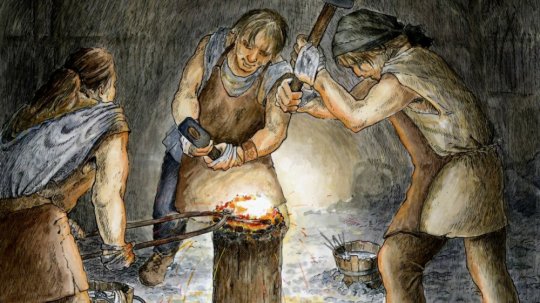

საზოგადოებრივი ეთიუნის სამეფო - ლჭაშენ-მეწამორის კულტურა 2021, 3 ოქტომბერი, 21:56 
ლჭაშენ-მეწამორის კულტურა (Lchashen-Metsamor culture) - ძვ.წ. 1500-700 წწ. მისი ტერიტორია ვრცელდებოდა ცენტრალური სომხეთის, სამხრეთ საქართველოს ნაწილის და აღმოსავლეთ თურქეთის ნაწილში, კერძოდ აგრის რეგიონში. ამ კულტურის 2 ინდივიდია გამოკვლეული გენეტიკურად, შედეგები ასეთია: Y-ქრომოსომული I2a2b-L596 ჰაპლოჯგუფი, ხოლო მიტოქონდრიული ჰაპლოჯგუფები: HV0a და J1b1a. ეს კულტურა მოხსენიებულია უძველეს წერილობით წყაროებში როგორც ეთიუნის სამეფო. ის სხვადასხვა წყაროში მოიხსნეიება, როგორც: ეთიუნი, ეთიუხი, ეთიუ, ეთიო, ეთუნა, ეთინა (Etiuni, Etiukhi, Etiu, Etio, Etuna, Etina). რკინის ხანის ტომობრივი ერთობით შექმნილი სახელმწიფო მდინარე არაქსის ჩრდილოეთ ნაწილში. ის ხშირადაა მოხსენიებული ურარტუელი მეფეების წარწერებში, რომლებმაც მრავალჯერ გააჩაღეს ომი ეთიუნის წინააღმდეგ. ასურული წერილობითი წყაროების მიხედვით, სწორედ ეთიუნმა ითამაშა დიდი როლი ურარტუს სამეფოს განადგურებაში. უდიდესი ალბათობით, ეთიუნელი ხალხი იყო ქართველურ ტომთა კავშირი ან შერეული ხურიტულ-ურარტული და ქართველური ხალხების სამეფოების კონ-ფედერაცია. თავად ეთიუნი შედგებოდა სხვა უფრო მცირე სამეფოებისგან და ტომებისგან, ერთ-ერთი მნიშვნელოვანი იყო აიას სამეფო, ასევე წოდებული, როგორც იია, იგანი და იგა (Aia, Iya, Igani, Iga), ასევე აბილიანი (Abiliani), აპუნი (Apuni) - ეს ორივე ყარსის რეგიონში მდებარეობდა, ასევე ლუშა (Lusha), ქათარზა (Katarza), ვიტეროხი (Viterokhi, Uiterukhi, Witerukhi), გულუთახი (Gulutakhi), რუიშია (Ruishia) და ერკუახი, ერკვახი (Erkuakhi, Erkuahi). ეთიუნის კიდევ ერთ რეგიონს (სამეფოს ან სამთავროს) ერქვა ლიქუინი, ლიქვინი (Liquini), რომელიც მდებარეობდა დღევანდელ არმავირთან. მეფე რუსას მიერ მოხსენიებულია ასევე მნიშვნელოვანი რელიგიური ცენტრის ფუნქციის მქონე ეთიუნური ქალაქი აზა ანუ აზარა (Aza, Azara), რომელიც გაშენებული იყო მდინარე არაქსზე. სტრაბონის მიხედვით ეს ქალაქი დღევანდელ არტაშატთან იყო ახლოს. ეთიუნის სხვა რეგიონები (სამეფოები) იყო ასევე ველიკუნი (Uelikuni, Welikuni) თილუხუ, ტილუხუ (Tilukhu, Tiluhu) სევანის ტბის დასავლეთ სანაპიროებზე და რეგიონი სახელად კეკუნი (Kekuni) ამავე ტბის ჩრდილოეთ სანაპიროზე. არქეოლოგიური ადგილი ლჭაშენი სინამდვილეში იყო ეთიუნის ერთ-ერთი უმნიშვნელოვანესი ქალაქი იშთიკუნი, იშტიკუნი (Ishtikuni). ურარტულ წარწერებში მოხსენიებულია "უდური-ეთიუნის ოთხი ხელმწიფე (Uduri-Etiuni)" - ეთიუნის კიდევ ოთხი რეგიონის მეფეები, ეს რეგიონები (ნახევრად დამოუკიდებელი სამეფოები) იყო ლუეხი (Luekhi), ქემანი (Kemani), ურტეხინი (Urtekhini) და არქუქინი (Arquqini). ეთიუნის კონ-ფედერაციის მეზობელი სახელმწიფოები იყო პროტო-ქართული სამეფოები დიაოხი (Diauehi, Diaokhi) დასავლეთიდან და კოლხა (Kulkhi, Kulhi, Kolkha, Colchis) ჩრდილოეთიდან და ჩრდილო-დასავლეთით. 
იშფუინის (ძვ.წ. 828-810 წწ.) და მისი ვაჟის, მენუას (ძვ.წ. 810-786 წწ.) მეფობისას ურარტუმ შეტევა დაიწყო ჩრდილოეთით ეთიუნის წინააღმდეგ და დაუწყო ომი ეთიუნის კონ-ფედერაციის ტომობრივ სამეფოებს, როგორიც იყო ქათარზა, ლუშა, ლიქუინი და "დიდებული ქვეყანა" ერკუახი. შედეგად კი მთელი ეთიუხი დახარკა. მენუას ვაჟი, არგიშთი I (ძვ.წ. 786-764 წწ.) კიდევ უფრო შიგნით შეიჭრა ეთიუნის ტერიტორიაზე და დაპყრობილ მიწაზე ააშენა ერებუნის ციხე-სიმაგრე, რომლის ადგილას დაარსდა შემდეგ ქალაქი ერებუნი. შემდგომში, მას მერე, რაც სომხები შემოვიდნენ ამ მიწებზე, ეწოდა ერევანი. ერებუნში არგიშთიმ 6600 ხათელი და შუპრიელი მეომარი დაასახლა. არგიშთიმ შემდეგ დაიპყრო აპუნი (Apuni) და ლუშა. ლუშას მეფეს კასტრაცია გაუკეთა. ასევე აიღო აიას სამეფო, იგივე იგას სამეფო და ამ ქვეყნის მცხოვრებთა დიდი რაოდენობა წაიყვანა ურარტუში, როგორც ომის ტყვეები. ეთიუნელები არგიშთის მეფობაშივე გადავიდნენ კონტრ-შეტევაზე, დაარბიეს ურარტუ და ალაფად ხელთ იგდეს აშთიუზი (შესაძლოა ეს იყო ერთ-ერთი მთავარი ღმერთის კერპი ურარტუში) და ურარტუს რელიგიური ცენტრი - ქალაქი მუსასირი. სარდური II-მ (Sarduri II - ძვ.წ. 764-735 წწ.), არგიშთის ვაჟმაც მრავალჯერ ილაშქრა ეთიუნის წინააღმდეგ ძვ.წ. 740-იან წლებში და ებრძოდა ადგილობრივ მმართველებს და მთავარ მეფეს - დიაშუნის (Diashuni). ძველი ასურული ტექსტების მიხედვით ეთიუნელები სამჯერ აუჯანყდნენ ურარტუს მეფე რუსა I-ს (ძვ.წ. 735-714 წწ.), სარდური მეორის (Sarduri II) ვაჟს. ეთიუნელებმა ამ სამხედრო დაპირისპირებებში დიდი გამარჯვებები მოიპოვეს და ურარტუ გაძარცვეს. შემდგომი პერიოდის ასურული წყაროები კი გადმოგვცემს, რომ ურარტუ "ეთუნას ხალხის" (People of Etuna) მიერ იქნა განადგურებული. ურარტუელები ეთიუნის მხოლოდ ერთ მეფეს ასახელებენ - აიას მეფე დიაშუნი, იგივე იგას მეფე დიაშუნი. ეთიუნს სხვა მრავალი მეფე ჰყავდა, რომელიც ამ დიდი კონ-ფედერაციის შემადგენელი მცირე სამეფოების თუ ტომთა მმართველები იყვნენ. ასეთი მეფეები და მმართველები იყვნენ: ველიკუნის მეფე მურინუ (Murinu of Uelikuni), აბილიანის მეფე მურინი (Murini of Abiliani), ლუეხის მეფე შინალბი (Shinalbi of Luekhi), რუიშიას მეფე რაშუ (Rashu of Ruishia) და აიას მეფე კაპურინი (Kapurini of Aia, Iga). კრებულები:1) მეცნიერება 2) მეცნიერება II 3) მეცნიერება III 4) სხვადასხვა 5) სხვადასხვა II 6) ქართული მითოლოგია 7) რელიგია 8) საქართველო 9) საქართველო II 10) ქართული სახელმწიფოები 11) პროტო-ქართველები 12) კავკასიური კულტურები 13) პარანორმალიავტორი: თორნიკე ფხალაძე232 1-ს მოსწონს |
The Urartians sometimes used the variation, Etiuḫi, which seems to have referred to the people of Etiuni specifically. Etiuni was compromised of a number of small kingdoms and tribes, included Iga (also known as Igani, Iya, and Aia). Abiliani and Apuni, probably corresponding to the Armenian Abełean and Havnunik, in Kars region, and the Luša, Katarza, Uiṭeruḫi (Witeruḫi), and Gulutaḫi, of the South Caucasus. Another region of Etiuni was Liquini, located near Armavir. The city of Aza, mentioned by Rusa as an important temple-city along the Araxes River, has been connected to the wealthy religious center, Azara, which was later placed by Strabo near Artashat. The Etiunian lands of Uelikuni (Welikuni) and Tiluḫu were located on the western shore of Lake Sevan and Kekuni was on the lake's northern shore. The archaeological site of Lchashen, probably corresponding to the city of Ishtikuni, was located in one of these kingdoms. The Urartians mentioned "the four kings of Uduri-Etiuni." This may have referred to a separate, but perhaps culturally and linguistically connected, confederation from Etiuni, comprising the lands Lueḫi, Kemani, Urteḫini, and Arquqini, stretching along the southern shore of Lake Sevan. The word "Uduri" probably means "water" (referring to its location along Lake Sevan). Etiuni was bordered by Georgian state Diaeuḫi to the west, Urartu and possibly the separate lands of Biani to
However, the Etiunians seem to have revolted and invaded Urartu during Argišti's reign, stealing the aštiuzi (perhaps an idol of a god, compare this word to Armenian Astuas (god)) of the Urartian religious center, Musasir.
Sarduri II, Argišti's son, also launched numerous military campaigns in Etiuni in the 740s BCE, battling with local rulers and the king of Etiuni, Diaṣuni. However, whatever became of this confrontation with Diaṣuni is unknown, as the text breaks off.
According to the Assyrians, "the Etinaeans" revolted three times during the reign of Rusa I, Sarduri II's son. These revolts apparently resulted in Urartian military losses and Urartu being "plundered."
A later Assyrian text mention that Urartu had been "destroyed" by the "people of Etuna."
The Urartians only named one king of Etiuni - Diaṣuni of Iga. Other kings of regions of Etiuni were likely rulers of smaller kingdoms or local chieftains. These included: Murinu of Uelikuni, Murini of Abiliani, Ṣinalbi of Lueḫi, Rashu of Ruishia, and Kapurini of Iga.
Archaeologists connect Etiuni with the Lchashen-Metsamor culture. Lchashen-Metsamor culture ultimately descends from the Trialeti-Vanadzor culture. Ishtikuni, near modern Lchashen, is a notable Etiunian archaeological site. The Metsamor site, near modern Taronik, was an important metal-working center during the Iron Age.
ანთია (Antia) - I1a3a1a - Y2245
არაბული (Arabuli) - I2a2b - Y16419
ბაკურაძე (Bakuradze ) - I2a2b - Y16419
ბაშარული (Basharuli) - I2a2b - Y16419
გაზდელიანი (Gazdeliani) - I2a2b - Y16419
გელაშვილი (Gelashvili) - I2a1b1a1b1 - L1229
გვათუა (Gvatua) - I2a2b - Y16419
გიგანი (Gigani) - I2a2b - Y16419
გუჯეჯიანი (Gudjedjiani) - I2a2b - Y16419
ვაჩნაძე (Vachnadze) – I2a2b - Y16419
ზარდიაშვილი (Zardiashvili) - I2a2b - Y16419
ზარიძე (Zaridze) - I2a2b - Y16419
თევდორაძე (Tevdoradze) - I2a2b - Y16419
თოფურია (Topuria) - I2a2b - Y16419
იდუკაშვილი (Idukashvili) - I2a2b - Y16419
იზორია (Izoria) - I2a2b - Y16419
კაპანაძე (Kapanadze) – I2a2b - Y16419
მოურავიძე (Mouravidze) - I2a2b - Y16419
ნიკოლაძე (Nikoladze) - I2a2b - Y16419
ჟორდანია (Zhordania) - I2a2b - Y16419
სახლთხუციშვილი (Sakhltkhucishvili) – I2a2b1f - BY2818
სილაგაძე (Silagadze) - I2a1b1a2a1a1 - A427
ტარიელაშვილი (Tarielashvili) – I2a2b - Y16419
ციციშვილი(Tcitcishvili) - I2a2b - Y16419
ციციშვილი(Tcitcishvili) - I2a1a2b1a1 - CTS10228
ჭინჭარაული (Tchintcharauli) - I2a2b - Y16419
ჯაბუშანური (Djabushanuri) - I2a2b - Y16419
ჯაჯანიძე (Djadjanidze) - I2a2b - Y16419